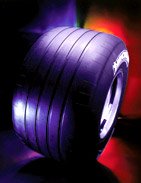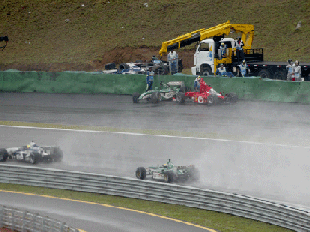(no frames? - click here)
![]()
The tread pattern of an F1 tyre and which particular pattern to use at any given time is dictated solely by the weather conditions.
![]()
 Slick
tyres are the ones that F1 drivers use most of the time - i.e. tyres suitable
for dry conditions. A normal slick tyre actually has no tread pattern at all!
This is because in dry conditions the aim is to get the maximum grip from the
tyre and this is achieved by having as much rubber in contact with the racetrack
as possible.
Slick
tyres are the ones that F1 drivers use most of the time - i.e. tyres suitable
for dry conditions. A normal slick tyre actually has no tread pattern at all!
This is because in dry conditions the aim is to get the maximum grip from the
tyre and this is achieved by having as much rubber in contact with the racetrack
as possible.
In fact there is a tread pattern of sorts on modern F1 tyres that was introduced as a safety measure from the 1998 season onwards. Four longitudinal grooves, each of 2.5mm depth, are cut into the tyres to reduce the area in contact with the road. This measure was introduced by the governing body of F1, the FIA, in order to artificially reduce the ever-increasing speeds of the cars to a safe level. Before 1998, dry weather tyres truly were "slicks" and had no tread pattern - simply a plain rubber surface.
 |
 |
|
Damon
Hill's 1996 slick tyre
|
Michael
Schumacher's 2002 slick tyre
|
![]()
 The presence of
water on the track surface changes the nature of interaction between tyre and
tarmac considerably. The long rubber molecules of the tyre can no longer interact
directly with the track surface to provide grip due to a thin film of water
being present between the tyre and track. In order to remove this film of water,
grooves have to be cut into the surface of the tyre which allows the water to
escape and the interactions between the track and tyre are re-established. The
particular pattern of grooves that the manufacturers apply to their wet tyres
varies but they are all designed to remove as much water as possible from the
racetrack, to allow the tyre to grip.
The presence of
water on the track surface changes the nature of interaction between tyre and
tarmac considerably. The long rubber molecules of the tyre can no longer interact
directly with the track surface to provide grip due to a thin film of water
being present between the tyre and track. In order to remove this film of water,
grooves have to be cut into the surface of the tyre which allows the water to
escape and the interactions between the track and tyre are re-established. The
particular pattern of grooves that the manufacturers apply to their wet tyres
varies but they are all designed to remove as much water as possible from the
racetrack, to allow the tyre to grip.
 |
|
Even
Schumacher can get caught out in the rain when grip levels are reduced
(Brazil 2003)
|
![]()
 Intermediate
tyres are exactly what their name suggests - a compromise between a full wet
and a fully slick tyre. They have slightly shallower grooves that are cut in
a different pattern and remove a fair amount of water from the racetrack surface
while also providing a decent level of grip once the track has dried. These
are the tyres that are used most often when weather conditions are bad. Only
in absolutely torrential conditions where there is continuous rain are the fully
wet tyres needed.
Intermediate
tyres are exactly what their name suggests - a compromise between a full wet
and a fully slick tyre. They have slightly shallower grooves that are cut in
a different pattern and remove a fair amount of water from the racetrack surface
while also providing a decent level of grip once the track has dried. These
are the tyres that are used most often when weather conditions are bad. Only
in absolutely torrential conditions where there is continuous rain are the fully
wet tyres needed.